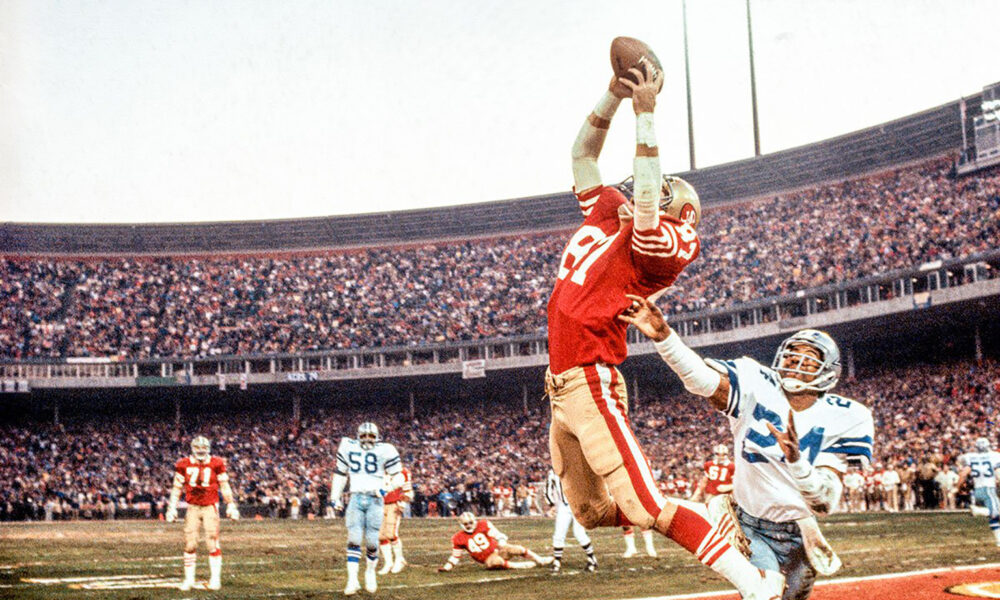Steve Fuller remembers Dwight Clark differently than most people. To Fuller, Clemson’s All-American quarterback and two-time ACC Player of the Year, he will always remember Clark as No. 30, the jersey he wore at Clemson from 1975-‘78.
“I know most of you are saying ‘Dwight Clark was eighty-seven.’ Yes he was,” Fuller said to a packed house vie a video at the South Carolina Football Hall of Fame Enshrinement Ceremony Thursday night at the Embassy Suites on Verdae in Greenville, S.C. “Eighty-seven was the one who won those Super Bowls. Eighty seven was the one who caught that amazing catch (against Dallas), but I remember him as number thirty.”
Clark came to Clemson with Fuller in 1975. The two became best friends and were roommates their entire college careers.
“He was my roommate, my teammate, my running mate and he caught my passes as number 30 so that is how I will remember him,” Fuller said.
Clark went on to a great career with the San Francisco 49ers after his days at Clemson. The Kinston, N.C., native played nine seasons with the 49ers, helping the franchise win two Super Bowls along the way. Twice he was named All-Pro and twice he played in the Pro Bowl. He led the NFC in receptions in 1981 and led the NFL in 1982.
The former Clemson receiver is most famously known for his winning catch in the back corner of the end zone to beat the Dallas Cowboys in the 1981 NFC Championship Game. The play is considered the greatest catch in NFL history and is simply known as “The Catch.”
“After that play, Emerson Walls, the cornerback for the Dallas Cowboys, said to Dwight, ‘You know you just beat America’s Team,’” said Clark’s former Clemson teammate and friend Joe Bostic, who accept the award on Clarks behalf. “Dwight responded the only way Dwight knew how. ‘Well, in two weeks you will be home with the rest of America watching us play in the Super Bowl.’”

Dwight Clark finished his career at Clemson with just 33 career receptions for 571 yards and three touchdowns. He averaged 17.3 yards per catch.
Clark’s No. 87 jersey at San Francisco has since been retired and in 1988 he was inducted in the Clemson athletic Hall of Fame. On Thursday, Clark was enshrined into the South Carolina Football Hall of Fame as part of the Class of 2018, along with John Abraham of the University of South Carolina, Paul Maguire of The Citadel, Clay Matthews Sr. of Georgia Tech and Richard Seymour of the University of Georgia.
As Fuller later described, Clark’s football career almost did not happen. When he and Clark were sophomores at Clemson, Clark had an amazing spring and thought he was in position to help the Tigers at wide receiver.
“Our spring practice was a war. It was as competitive as heck and Dwight Clark was the star of that spring practice,” Fuller said. “That is when he started to show his toughness and his resilience.”
But when the spring ended, Clark was not a starter at wide receiver, but instead was the starting strong safety.
“He did not like it much and I did not like it much because I wanted him catching my passes,” Fuller said.
Clark hated it so much, he left Clemson and went back to his hometown in North Carolina.
“I remember the phone call like it was yesterday,” Fuller said. “Coach (Red) Parker called the house and said, ‘Steve, Dwight has gone home. You need to go up to Charlotte and get him. I said, ‘Excuse me. What is going on there?’ That is a true statement. Dwight wanted to play offense and had left school for a few days and headed home to try to decide if he was going to come back or play basketball at Appalachian State.”
Clark was an excellent basketball player in high school and App State offered him a scholarship when he was coming out.
Fuller and teammate Cliff Bray got in Fuller’s car that afternoon and drove just outside of Charlotte to sit down in the Clark home and try to convince Clark to come back to Clemson.
“Fortunately, after a few hours we did,” Fuller said. “We convinced him he could play offense and Coach Parker said that was okay. So Dwight came back and we started something that became special. Dwight, that was a little bump in your path towards greatness and I was so pleased to have you back.”

Dwight Clark is introduced to a standing ovation during the fourth inning last April between the San Francisco Giants and the San Diego Padres at AT&T Park. (Photo Credit: Kelley L Cox-USA TODAY Sports)
Because he played alongside Jerry Butler, who was a first-round draft pick in the 1979 NFL Draft, and the fact Clemson did not throw the ball very much in those days, Clark finished his career at Clemson with just 33 career receptions for 571 yards and three touchdowns. He averaged 17.3 yards per catch.
In 1978, Clark was second on the team behind Butler with 11 receptions for 207 yards, including a career-long 68-yard touchdown reception at Maryland that helped the Tigers win the ACC Championship. The Tigers finished 1978 at 11-1 and No. 6 in the final Associated Press Poll.
Clark was selected in the 10th round by the 49ers at 249 overall in the 1979 NFL Draft. In San Francisco, he played in 134 games, started in 97, while catching 506 passes for 6,750 yards and scoring 48 touchdowns.
These days Clark, 61, is living in Santa Cruz, Calif., with his family. However, he is facing another bump in his journey and it’s the biggest one he has ever had to get over. Last year, the Clemson Hall of Famer was diagnosed with ALS, also known as Lou Gehrig’s Disease, and because of his health he was unable to fly across country to accept his enshrinement into the South Carolina Football Hall of Fame.
But Fuller summed up Clark’s fight against ALS better than anyone can.
“I tried to think of one short way to describe you on this night of your honor. Certainly you were athletic. You could jump and you could catch and you could do a lot of really good things,” the former Clemson quarterback said. “But, I remember one thing late in spring practice early that year, and this how I like to remember you. You were never first in the first sprint of the day, but you were always first in the last sprint of the day. That tells me a lot about your character.”
